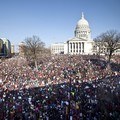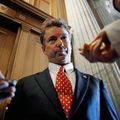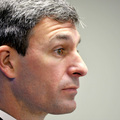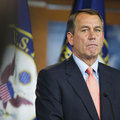A reader and friend asked me what I thought about a paper out of the University of Colorado projecting a (relatively) big win coming this fall for Mitt Romney in the electoral college, in this Q&A I did yesterday for anything and everything political. he paper, by political science professors Kenneth Bickers and Michael Berry (hereby referred to as the Bickers-Berry model), seems heavily weighted by economic factors and predicts Romney winning every single swing state, for a 320-218 electoral vote victory.
Bickers and Berry are touting their model has correctly predicting every presidential election since 1980, but that's misleading. This model (as Nate Silver notes below in a Tweet I'll quote) is a new model, and hasn't correctly predicted anything yet. It would have predicted past elections if it had existed before each of them took place, but that's entirely different than claiming that it has already predicted them.
Here's what I said in a very rushed analysis, without having read the paper:
What they did is develop a model and then tweak it until it correctly predicted known results from the past. That's not the same thing as developing a model in the past that has correctly predicted future results. What they did is pretty easy and intellectually lazy and dishonest. It's the mathematical equivalent of making a bold and unproven claim, being challenged, and then going out to find data that supports your view.
I'm not saying *they* are dishonest, cheating, or biased. These guys probably understand exactly what they did and what they have as a result, and some press folks are predictably blowing it up into something it's not.
Nate Silver is one of the smartest statistics people around, and his electoral models don't stop at economic indicators. They factor in a large number of weighted variables and I'd trust his model above virtually all others.
More than that, the Berry-Bickers model is a wicked outlier. Literally no other model agrees with it. That doesn't make it wrong, but it means the odds of it being right are very, very low.
There are also counter-indicators to consider. I don't use models, but I did spend a full evening researching the current state of electoral projections back in July (I didn't finish it so I never published it). Two of the things I did was look at polls for each swing state, their history of voting, going back about 60 years.
Every swing state I looked at had Barack Obama leading in polls, although Romney had a closing trend in his favor in a few of them. Several of those states weren't true swing states anymore, and I suspect you'll see Iowa specifically stop being called a swing state over the next decade, as the press catches up to a reality that I documented last month. Here's what I wrote about Iowa:
Obama has led in Iowa ever since October of last year. His initial lead was a comfortable 4 points, but narrowed until one poll released on February 15th, 44.7-43.8, favoring Obama. There haven't been very many polls since. Obviously that's going to change for all of these states as we get closer to November. The trend since February, thin as it is, has been Obama and Romney both gaining in standing, with Obama gaining slightly faster. The most recent poll has Obama up 45.6-44.4, well within the margin of error.
As far as polling goes, it being thin and close, the things that matter tend to fall for Obama. He has a lead now, has had it all year and into last year, and is pulling away from Romney, albeit at a snail's pace. Obama has led in 5 of the last 9 polls, 2 of the last 4, and tied once.
Statistically speaking it's a dead heat. But again, all the little ifs, ands, and buts all seem to fall into Obama's lap.
Iowa looks like a swing state from a distance, voting for a Democrat 6 times, and a Republican 9 times in the last 15 elections. Upon closer inspection though, this state is quickly becoming blue, which makes the polling results somewhat confusing. The state has voted for the Democratic candidate in 5 of the last 6 elections: Obama, Bush, Al Gore, Clinton, Clinton, and Michael Dukakis. Before that, it voted for Reagan, Reagan, Gerald Ford (R), Nixon, Nixon, LBJ (D), Nixon, Eisenhower (R), and Eisenhower.
That's 8 of 9 for Republicans starting in 1952, and 5 of 6 for Democrats beginning in 1988.
Obama won Iowa 54-44 in 2008.
The only explanation for the extremely close polls is that the state has really soured on Obama personally and isn't sure it wants another four years of having him around. It's not because of the economy, that's for sure. Iowa's unemployment rate is 5.2%, barely more than half the national rate. But whatever it is, Iowan's are deeply divided over who to vote for this fall.
Obama has a statistically insignificant lead, but a lead nonetheless, a lead which is growing (barely), won the state easily in 2008, and the state has gone blue in a big way in the past 24 years. When push comes to shove, it's another "leans Obama", because no matter how close the polls are, there won't be any undecideds on election day. It won't be 45-45. Somebody has to win there. Remember that North Carolina in 2008 was decided by about 14,000 votes, but it was decided regardless.CNN, Real Clear Politics, Nate Silver (fivethirtyeight/New York Times), Pollster (Huffington Post, but well respected and neutral), and I think Washington Post all have significant leads for Obama that put him so close to winning that all he needs in most models is Florida, or about 20-25% of the tossup electoral votes. Romney needs 80-75% in most models to win, which means he couldn't do it just by winning Florida on top of his safe states and leaners.
Here are some things that the aforementioned Nate Silver said on Twitter last night:
A Denver Post reporter asked me (bit.ly/MNOF1C) about this U. of Colorado election model (bit.ly/O7pN4I). (1/5)
— Nate Silver (@fivethirtyeight) August 23, 2012
It's late, so I'll be blunt: I saw their paper and I think there are glaring problems with their methodology. (2/5)
— Nate Silver (@fivethirtyeight) August 23, 2012
The U. of Colo. model fits the equivalent of 7 unknowns to 8 elections. That's not a good idea. (3/5)
— Nate Silver (@fivethirtyeight) August 23, 2012
If you want a "fundamentals" model that shows Romney winning, the Hibbs model is a lot more sensible. bit.ly/SqgfnH (5/5)
— Nate Silver (@fivethirtyeight) August 23, 2012
Also, it's false advertising to claim CU model has predicted the last 8 elections right. It's a new model. Hasn't predicted anything yet.
— Nate Silver (@fivethirtyeight) August 23, 2012
And Today:
Another huge flaw with that U. Colorado election model: it actually assumes a Dem incumbent does WORSE when state income growth is higher.
— Nate Silver (@fivethirtyeight) August 24, 2012
So, for example, the U. Colo. model has Obama's vote dropping off MORE in Ohio because its economy is relatively good.
— Nate Silver (@fivethirtyeight) August 24, 2012
It's surprising how often studies that fail a sanity check can pass peer review.
— Nate Silver (@fivethirtyeight) August 24, 2012
Make of it what you will, but it seems to me that this model has serious issues that need to be addressed before it can be trusted on any level.










